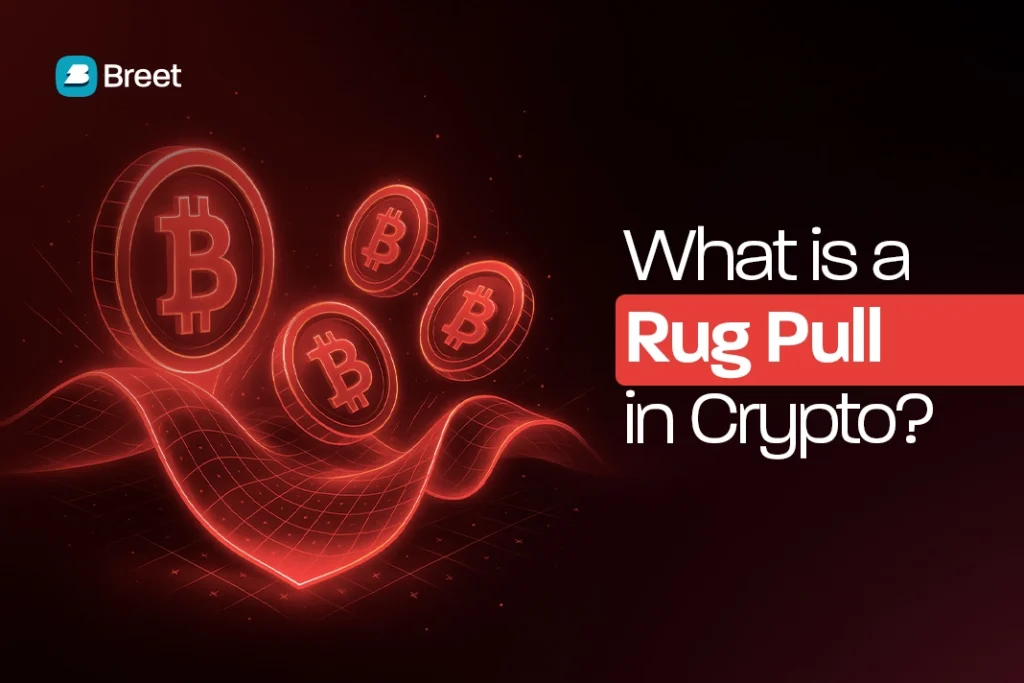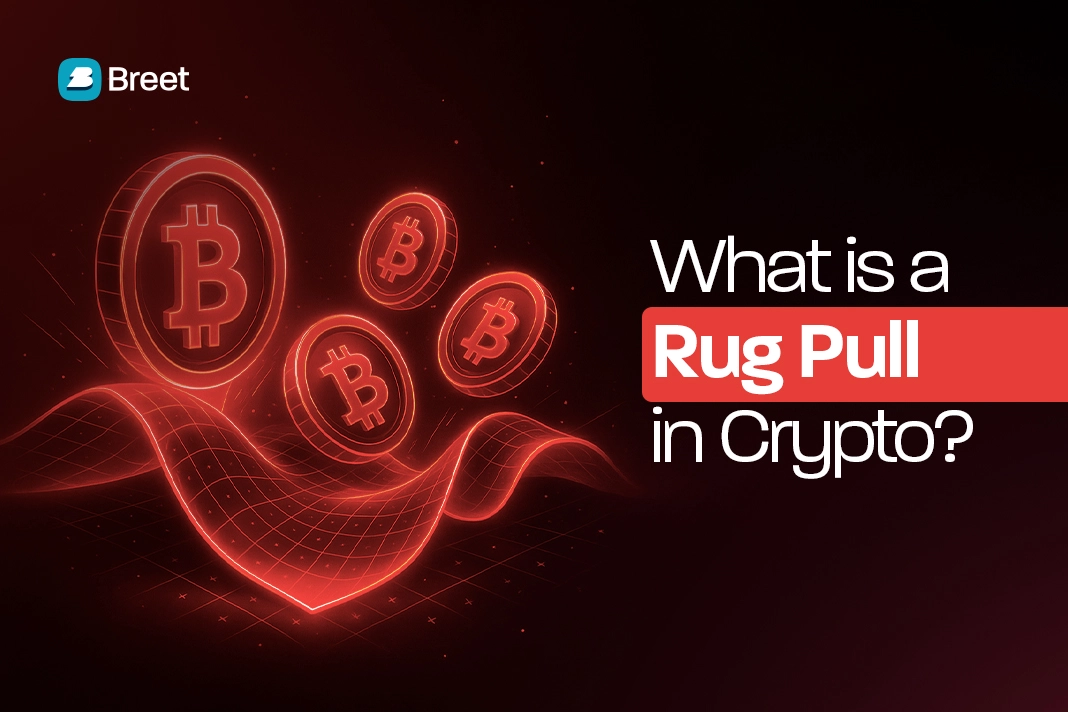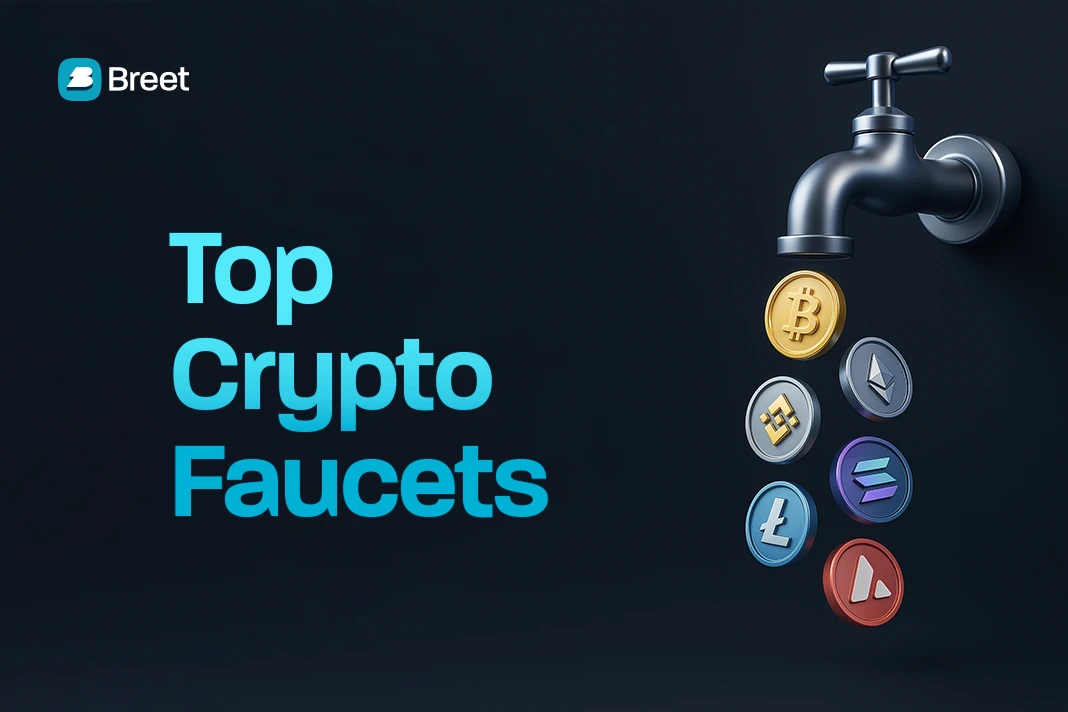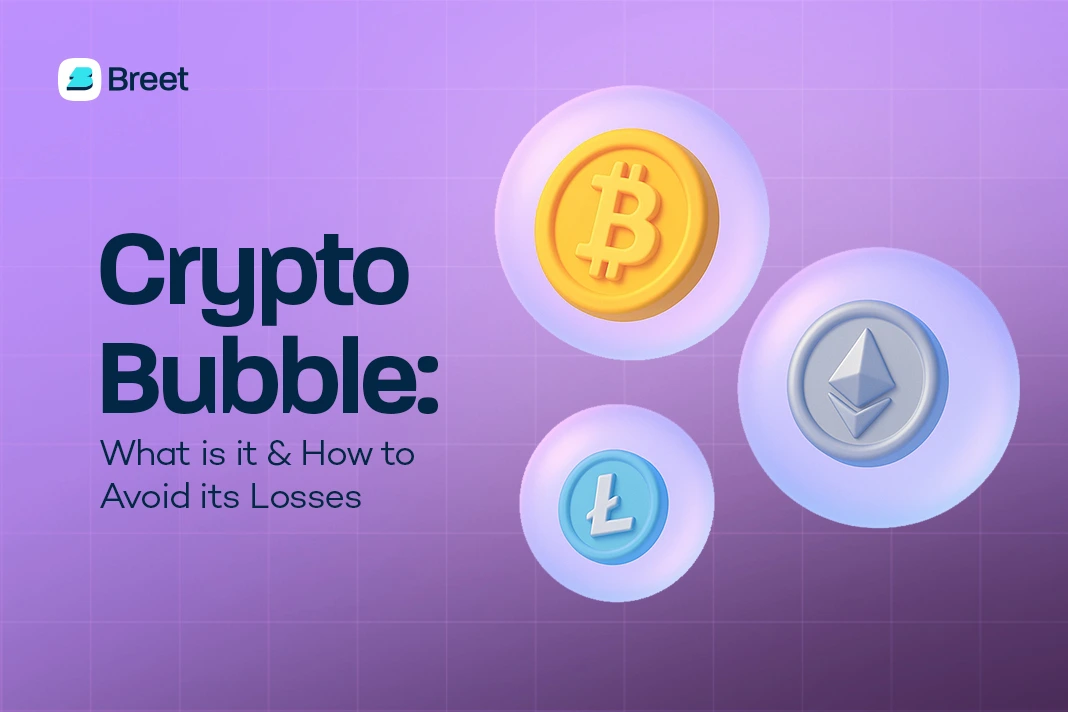A rug pull in crypto is a type of scam that happens when crypto founders or developers disappear with investors’ money. The term comes from the phrase “pulling the rug out” from under someone.
Typically, a rug pull happens mainly in DeFi or decentralized finance. The developers create a new coin or token and list it on a decentralized exchange (DEX).
Once a lot of people buy it, the developers call it off. They withdraw all the assets, usually as Bitcoin or Ethereum. The token’s price crashes to zero and you are left with worthless tokens. But that’s just the tip of the iceberg.
Related:
- What is JPYC Stablecoin? All You Need to Know
How Rug Pulls Work
A rug pull in crypto follows a simple plan. Scammers create a new token or coin first.
They promise huge returns and attract investors, listing this fake token on a DEX. Then they pair it with a major coin like Ethereum or Bitcoin, creating a liquidity pool. To you, it’s just the usual crypto game.
Next, the developers sell the coin heavily with social media like Telegram and Twitter.
They even hire influencers to create excitement. People buy quickly and its price goes up fast. You think it’s a huge success, but this price spike is the peak of the scam.
Once the pool holds enough money, the scammers withdraw all the paired crypto (Ethereum or Bitcoin), emptying the entire pool of real assets.
This is the core of the rug pulls; the real assets are gone, the fake token becomes useless. As a final trick, the price that was soaring before now crashes to zero.
Types of Rug Pulls in Crypto
A rug pull in crypto can happen in different ways. Here are the three main types:
1. Liquidity Rug Pulls
This is the most common type of rug pull. Developers create a new token, pair it with a major coin and place both into a liquidity pool on a DEX. To make you trust them, they might “lock” some liquidity at first. Once enough investors join, they drain the entire pool of real money.
This makes the project’s token worthless and the developers vanish with the pooled Ethereum or Bitcoin. Meanwhile, your wallets are drained completely.
2. Limitless Minting
This uses a hidden feature. The developers secretly write a function into the token’s smart contract, giving them power to create an unlimited number of new tokens.
Once the price rises, they create billions of new tokens instantly. They then dump these worthless tokens onto the exchange. The sudden surge crushes the price. Just think about how useless Bitcoin would be if we had too much in the system. That’s what happens here.
3. Limiting Sell Orders (The Honeypot)
This also involves hidden codes in the smart contract.
Here, the developers add a bug that only allows buying the token. The code prevents almost all other users from selling or transferring their tokens. When investors try to take profit, the transaction fails. Meanwhile, the developers’ own wallets are whitelisted, meaning they are the only ones that can sell their holdings.
4. Project Abandonment
Here, the scammers build a website and several social media pages. They promise you a grand project, like a new game or NFT collection. They sell tokens or NFTs based on this hype, raising a lot of money from investors.
Once the funds are in, the developers simply stop working.
Their social media goes silent and their website vanishes overnight. They abandon the project entirely and keep the capital. All you have now are tokens for a project that will never launch.
5. Soft Rug Pulls
A soft rug pull is more subtle than a hard, instant drain. Developers do not drain the whole liquidity pool at once. Instead, they gradually sell their huge holdings over many days or weeks.
Once the price is high, they dump their tokens slowly on the market. This causes the price to bleed out over time. The sad part: you’ll think it’s a normal market correction.
Recommended:
- 13 Best Crypto Faucets That Actually Work
Examples of Famous Rug Pulls in Crypto
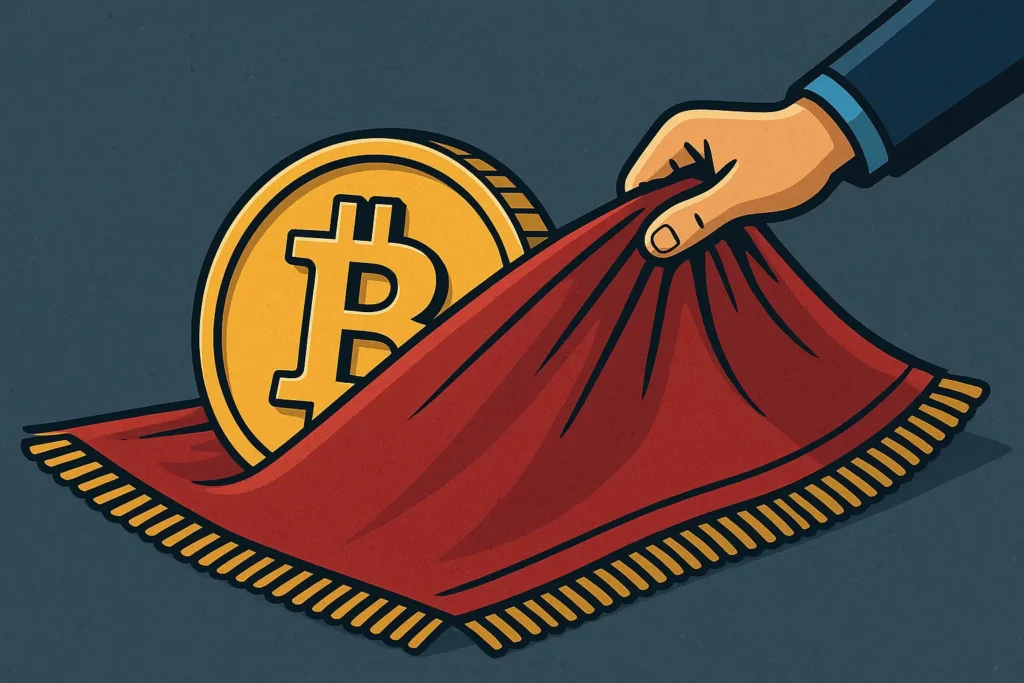
Understanding a few famous scams can tell you how rug pulls happen in real life. Let’s see three of the most recent ones:
1. The Squid Game Token (2021)
Almost everyone bought this. The developers launched a token named SQUID, using the hype of the popular Netflix show, Squid Game.
The token price went from a few cents to thousands of dollars in about a week. However, the developers had hidden a flaw in the code; a bug that prevented almost all investors from selling their tokens. Only the developers could sell their own holdings, instantly crashing the price to zero. At the end, they walked away with $3.38 million.
2. The AnubisDAO Heist (2021)
AnubisDAO was another huge and fast DeFi scam. The developers promised a decentralized currency and quickly raised $60 million in Ethereum from investors. Everything happened just 20 hours after the launch. The developers drained the entire liquidity pool and stole all the raised Ethereum. A day after the launch, the project token became worthless.
3. SafeMoon Alleged Slow Rug (2021–2023)
SafeMoon was a really popular token back in 2021. The developers promised that its liquidity pool was “locked” and completely safe. Thinking it was truly secure, investors bought the tokens and the value went up to billions of dollars very quickly. However, there was one little issue; the executives secretly kept access to the liquidity.
With time, they stole millions of dollars, causing the token’s value to drop massively. In fact, the price dropped by over 98% from its high. Luckily, in late 2023, they were arrested and charged with fraud.
4. Frosties NFT Scam (2022)
Even NFTs are not safe from a rug pull in crypto. The developers launched the Frosties NFT collection, promising a future Metaverse game. Of course, it sold out quickly, raising about $1.3 million (335 ETH) in total.
Right after the sale, the team vanished. In fact, they shut down the project’s website and Discord channels. Then they transferred millions of dollars to other untraceable wallets and left investors with useless tokens.
5. Pixelmon NFT Partial Rug (2022)
This was probably the most anticipated NFT project in 2022. The developers promised amazing, AAA-quality creatures for a metaverse game, so investors raised over $70 million during the sale. Right when the NFTs were revealed though, the artwork was so bad in quality and buggy.
The lead developer later claimed he messed up, leading to a crash in the NFT floor price. Still, there were no refunds; the developers ran off with the $70 million.
Read Also:
- How to Generate a Free Bitcoin Invoice
How to Avoid Rug Pull Scams in Crypto
Protecting yourself from a rug pull in crypto requires careful work. You must always think before investing any money. Here are key steps to stay safe:
1. Do Your Own Research
Don’t invest based on hype alone. Read the project’s whitepaper carefully. Ask yourself: What problem does this project actually solve? Does it have a clear product roadmap? If the only talk is about price, stay away.
2. Check the Team’s Identity
Most legit projects have a “doxxed” team. This means the developers publicly share their real names and experience. A completely anonymous team is a big red flag for a potential rug pull. They can disappear easily without consequences.
3. Verify Liquidity Locks
The most effective way to prevent a rug pull in crypto is to check the lock status. Liquidity should be “locked” for a long time. This prevents the developers from draining the pool. A short lock time or no lock at all is a clear warning sign.
4. Audit Reports and Contract Code
Real projects hire security firms to audit their contracts. An audit report tells you that the code has been reviewed for hidden flaws. Look for the official audit report on the project’s website. You should also check the contract code itself. If it has a function that allows the developer to mint unlimited tokens, it’s definitely a rug pull.
5. Start Small and Be Patient
Avoid the temptation to invest heavily in a new, unknown coin. Many rug pulls happen within the first few days. Wait a few weeks or months. See if the team kept its promises and are not just pumping the price.
Frequently Asked Questions (FAQs) About Rug Pulls in Crypto
Here are answers to some commonly-asked questions about rug pulls in crypto:
What is the Biggest Sign before a Rug Pull?
The biggest red flag is locked selling. Scammers allow you to buy the token easily. They write code that prevents you from selling your tokens back. If you cannot sell, it’s a huge sign of a rug pull.
What should I do Immediately I Realize a Rug Pull is Happening?
If the price is crashing, sell whatever you can immediately. It is better to recoup a small amount of money than to lose it all. After this, secure all your accounts and report the scam to the support team of your exchange platform.
Can I Get my Money back after a Crypto Rug Pull?
It is really difficult to get your money back. Crypto transactions are generally irreversible, so your best step is to immediately report the fraud to authorities. You can try to track the stolen assets using blockchain explorers, but it’s very stressful.
What is the Difference Between a Hard Rug Pull and a Soft Rug Pull?
A hard rug pull involves malicious code, like a bug written into the contract. A soft rug pull is less technical; the developers just sell off their large supply quickly, tanking the price before they abandon the project.
How is a Rug Pull Different from a Pump-and-dump Scheme?
A rug pull is a theft of the project’s liquidity by the developers. On the other hand, a pump-and-dump is an organized group artificially inflating the price and then selling their own coins. Anyone can do a pump-and-dump, but only developers can execute a rug pull.
A Note on Secure Selling
If you make profit, you need a safe way to cash out. Many rug pulls involve scammers trying to buy crypto P2P. They try to trick you when you sell. For African investors, using a secure, non-P2P platform like Breet is best.
Breet automatically converts your Bitcoin or Litecoin to cash. It transfers the funds instantly to your bank. This process removes the risk of dealing with scammers or facing a rug pull when selling. Always choose security.
